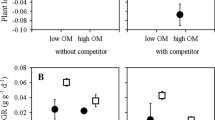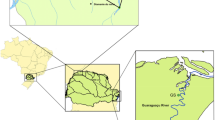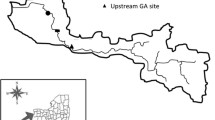Abstract
Exotic species can invade and establish new habitats both as a result of their own traits, and as a result of the characteristics of the environment they invade. Here, we show that the abundance of the invasive submerged aquatic plant, Myriophyllum spicatum (Eurasian watermilfoil) is highly dependent on the conditions of the environment in a mesocosm experiment. M. spicatum is allelopathic towards epiphytic algae, and in the absence of algivorous snails, we found that the abundance of both algae and M. spicatum significantly increased with experimentally increased nutrient loading, while the abundance of native submerged macrophytes declined. However, when snails were present, snail biomass increased with increasing nutrient loading, and M. spicatum biomass was consistently low while native submerged macrophyte biomass was consistently high. Our results stress the importance of the interaction between species traits and environmental conditions when considering the invasiveness of certain exotic species and the invasibility of certain environments.
Similar content being viewed by others
References
Bates AL, Burns ER and Webb DH (1985) Eurasian watermilfoil (Myriophyllum spicatum L.) in the Tennessee-valley: an update on biology and control. In: Proceedings First International Symposium on Water-milfoil and Related Haloragaceae Species, Aquatic Plant Management Society, Vancouver British Columbia
B Bolding SA Bonar M Divens (1998) ArticleTitleWalleye diet in a shallow impoundment: relative importance of pumpkinseed sunfish and yellow perch Journal of Freshwater Ecology 13 9–14
C Brönmark (1989) ArticleTitleInteractions between epiphytes, macrophytes and freshwater snails – A review Journal of Molluscan Studies 55 299–311
C Brönmark SP Klosiewski RA Stein (1992) ArticleTitleIndirect effects of predation in a fresh-water, benthic food-chain Ecology 73 1662–1674 Occurrence Handle10.2307/1940018
RM Callaway WM Ridenour (2004) ArticleTitleNovel weapons: invasive success and the evolution of increased competitive ability Frontiers in Ecology and the Environment 2 436–443
Carpenter S, Caraco N, Correll DL, Howarth RW, Sharpley AN and Smith VH (1998) Nonpoint Pollution of Surface Waters with Phosphorus and Nitrogen. Issues in Ecology No. 3
JM Chase (2003) ArticleTitleExperimental evidence for alternative stable equilibria in pond food webs Ecology Letters 6 733–741 Occurrence Handle10.1046/j.1461-0248.2003.00482.x
Couch R and Nelson E (1985) Myriophyllum spicatum in North America. In: Proceedings First International Symposium on Water-milfoil and Related Haloragaceae Species. Aquatic Plant Management Society, Vancouver British Columbia
CC Daehler (2003) ArticleTitlePerformance comparisons of co-occurring native and alien invasive plants: implications for conservation and restoration Annual Review of Ecology, Evolution, and Systematics 34 183–211 Occurrence Handle10.1146/annurev.ecolsys.34.011802.132403
MA Davis JP Grime K Thompson (2000) ArticleTitleFluctuating resources in plant communities: a general theory of invasibility Journal of Ecology 88 528–534 Occurrence Handle10.1046/j.1365-2745.2000.00473.x
NJ Dorn GG Mittelbach (1999) ArticleTitleMore than predator and prey: a review of interactions between fish and crayfish Vie et Millieu 49 229–237
NJ Dorn JM Wojdak (2004) ArticleTitleThe role of omnivorous crayfish in littoral communities Oecologia 140 150–159 Occurrence Handle15064944 Occurrence Handle10.1007/s00442-004-1548-9
RW Drenner KD Hambright (2002) ArticleTitlePiscivores, trophic cascades, and lake management Scientific World Journal 2 284–307 Occurrence Handle12806017 Occurrence Handle1:CAS:528:DC%2BD38XktF2jtLk%3D
ME Eiswerth SG Donaldson WS Johnson (2000) ArticleTitlePotential environmental impacts and economic damages of Eurasian watermilfoil (Myriophyllum spicatum) in western Nevada and northeastern California Weed Technology 14 511–518 Occurrence Handle10.1614/0890-037X(2000)014[0511:PEIAED]2.0.CO;2
S Engel (1987) ArticleTitleThe impact of submerged macrophytes on largemouth bass and bluegills Lake and Reservoir Management 3 227–234 Occurrence Handle10.1080/07438148709354778
EM Gross H Meyer G Schilling (1996) ArticleTitleRelease and ecological impact of algicidal hydrolysable polyphenols in Myriophyllum spicatum Phytochemistry 41 133–138 Occurrence Handle1:CAS:528:DyaK28XisVWqsA%3D%3D Occurrence Handle10.1016/0031-9422(95)00598-6
EM Gross (2000) ArticleTitleSeasonal and spatial dynamics of allelochemicals in the submersed macrophyte Myriophyllum spicatum L Verhulst International Limnology 27 2116–2119 Occurrence Handle1:CAS:528:DC%2BD3MXovV2qtL4%3D
AM Hill DM Lodge (1999) ArticleTitleReplacement of resident crayfishes by an exotic crayfish: the roles of competition and predation Ecological Applications 9 678–690 Occurrence Handle10.2307/2641154
RJ Hobbs LF Huenneke (1992) ArticleTitleDisturbance, diversity, and invasion: implications for conservation Conservation Biology 6 324–337 Occurrence Handle10.1046/j.1523-1739.1992.06030324.x
CJF Huckins (1997) ArticleTitleFunctional linkages among morphology, feeding performance, diet, and competitive ability in molluscivorous sunfish Ecology 78 2401–2414 Occurrence Handle10.2307/2265902
CJF Huckins CW Osenberg GG Mittelbach (2000) ArticleTitleSpecies introductions and their ecological consequences: an example with congeneric sunfish Ecological Applications 10 612–625 Occurrence Handle10.2307/2641119
SH Huskey RG Turingan (2001) ArticleTitleVariation in prey-resource utilization and oral jaw gape between two populations of largemouth bass, Micropterus salmoides Environmental Biology of Fishes 61 185–194 Occurrence Handle10.1023/A:1011095526939
E Leu A Krieger-Liszkay C Goussias et al. (2002) ArticleTitlePolyphenolic allelochemicals from the aquatic angiosperm Myriophyllum spicatum L. inhibit photosystem II Plant Physiology 130 2011–2018 Occurrence Handle12481084 Occurrence Handle1:CAS:528:DC%2BD3sXktlOh Occurrence Handle10.1104/pp.011593
JM Levine CM D’Antonio (1999) ArticleTitleElton revisited: a review of evidence linking diversity and invasibility Oikos 87 15–26
RA Lillie J Budd (1992) ArticleTitleHabitat architecture of Myriophyllum spicatum as an index to habitat quality for fish and macroinvertebrates Journal of Freshwater Ecology 7 113–125
DM Lodge MW Kershner JE Aloi et al. (1994) ArticleTitleEffects of an omnivorous crayfish (Orconectes rusticus) on a freshwater littoral food-web Ecology 75 1265–1281 Occurrence Handle10.2307/1937452
AS MacDougall R Turkington (2005) ArticleTitleAre invasive species the drivers or passengers of change in degraded ecosystems Ecology 86 42–55
JD Madsen (1997) Methods for management of nonindigenous aquatic plants JO Luken JW Thieret (Eds) Assessment and Management of Plant Invasions Springer-Verlag New York 145–171
JD Madsen JW Sutherland JA Bloomfield et al. (1991) ArticleTitleThe decline of native vegetation under dense Eurasian watermilfoil canopies Journal of Aquatic Plant Management 29 94–99
JD Madsen (1998) ArticleTitlePredicting invasion success of Eurasian watermilfoil Journal of Aquatic Plant Management 36 28–32
T Mehner R Arlinghaus S Berg H Dörner L Jacobsen P Kasprzak R Koschel T Schulze C Skov C Wolter K Wysujack (2004) ArticleTitleHow to link biomanipulation and sustainable fisheries management: a step-by-step guideline for lakes of the European temperate zone Fisheries Management and Ecology 11 261 Occurrence Handle10.1111/j.1365-2400.2004.00401.x
S Nakai Y Inoue M Hosomi A Murakami (1999) ArticleTitleGrowth inhibition of blue-green algae by allelopathic effects of macrophyte Water Science and Technology 39 47–53 Occurrence Handle10.1016/S0273-1223(99)00185-7
Newroth PR (1985) A review of Eurasian water milfoil impacts and management in British Columbia. In: Proceedings First International Symposium on Water-milfoil and Related Haloragaceae Species. Aquatic Plant Management Society, Vancouver, British Columbia
CW Osenberg (1989) ArticleTitleResource limitation, competition and the influence of life history in a freshwater snail community Oecologia 79 512–519 Occurrence Handle10.1007/BF00378669
FJ Rahel (2002) ArticleTitleHomogenization of freshwater faunas Annual Review of Ecology and Systematics 33 291–315 Occurrence Handle10.1146/annurev.ecolsys.33.010802.150429
AK Sakai FW Allendorf JS Holt DM Lodge J Molofsky KA With S Baughman RJ Cabin JE Cohen NC Ellstrand DE McCauley P O’Neil IM Parker JN Thompson SG Weller (2001) ArticleTitleThe population biology of invasive species Annual Review of Ecology and Systematics 32 305–332 Occurrence Handle10.1146/annurev.ecolsys.32.081501.114037
K Sand-Jensen J Borum (1991) ArticleTitleInteractions among phytoplankton, periphyton and macrophytes in temperate freshwaters and estuaries Aquatic Botany 41 137–175 Occurrence Handle10.1016/0304-3770(91)90042-4
K Sand-Jensen M Søndergaard (1981) ArticleTitlePhytoplankton and epiphyte development and their shading effect on submerged macrophytes in lakes of different nutrient status Internationale Revue der Gesamten Hydrobiologie 66 529–552
K Shea P Chesson (2002) ArticleTitleCommunity ecology theory as a framework for biological invasions Trends in Ecology and Evolution 17 170–176 Occurrence Handle10.1016/S0169-5347(02)02495-3
D Simberloff M Holle ParticleVon (1999) ArticleTitleSynergistic interactions of nonindigenous species: invasional meltdown? Biological Invasions 1 21–32 Occurrence Handle10.1023/A:1010086329619
DL Strayer (1999) ArticleTitleEffects of alien species on freshwater mollusks in North America Journal of the North American Benthological Society 18 74–98 Occurrence Handle10.2307/1468010
RD Valley RM Newman (1998) ArticleTitleCompetitive interactions between Eurasian watermilfoil and northern watermilfoil in experimental tanks Journal of Aquatic Plant Management 36 121–126
M. Williamson (1996) Biological Invasions Chapman & Hall London
Author information
Authors and Affiliations
Corresponding author
Rights and permissions
About this article
Cite this article
Chase, J.M., Knight, T.M. Effects of eutrophication and snails on Eurasian watermilfoil (Myriophyllum spicatum) invasion. Biol Invasions 8, 1643–1649 (2006). https://doi.org/10.1007/s10530-005-3933-7
Received:
Accepted:
Issue Date:
DOI: https://doi.org/10.1007/s10530-005-3933-7




